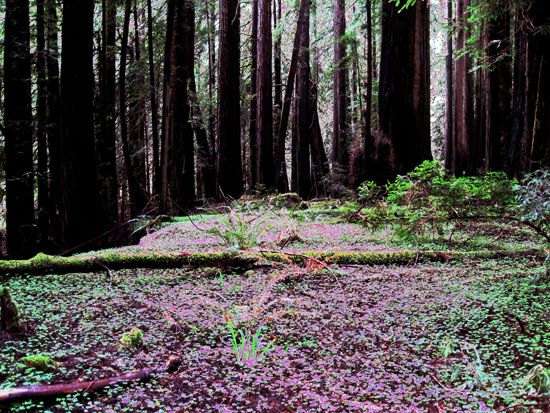
Given Eric Holder's announcement that the DOJ will not interfere with states' decisions on the issue of marijuana legalization, the matter of 'pot' and its many tentacles is big news these days. Add to that conversation the fact of Dan Rather's recent foray into the famed "Emerald Triangle" -- Humboldt, Mendocino and Trinity Counties in northern California -- where he did a flyover while reportedly investigating the impact of pot grows and other aspects of the cannabis industry, and it becomes clear pot is pulling attention from a wide variety of angles. But beyond legalization, what any flyover, any conversation, is obligated to include is the industry's impact on the environment -- inclusive of animal, vegetable and mineral -- which is profound and growing.
Illegal grows -- particularly those of the industrial kind -- are not only making billions (some suggest in the arena of $14 billion annually) for their under-the-radar harvesters, but they're literally destroying thousands of acres of natural land, killing wildlife (some of the endangered kind), and polluting and/or destroying natural streams, amongst other ecological impacts.
Of course, you bring up pot -- smoking, growing, selling, legalizing -- and there's a certain wink-and-nod response; a sense that it's all seen as generally harmless -- certainly as compared to alcohol with its death, drunkenness, and devastation. And as a clear bonus, 1.) pot does have bona fides as a medical aid (confirmed even by CNN's Sanjay Gupta in wide media coverage) and, 2.) it grows fairly easily in nature, offering a presumed degree of "green cred." People openly work as trimmers in grow fields, college students make an easy buck transporting and selling; frankly, unlike the mobster bootleggers of Prohibition, the "brand" of pot criminality is more a laid-back outlaw vibe than one of gut-toting sociopaths. But what's being ignored, beyond the chilling fallacy of that brand, is the long-lasting impact of grow fields on our natural lands.
No area of the country is as linked with pot culture as the Emerald Triangle, with Humboldt County literally making its name on the ubiquitous weed. Known to grow some of the most sought-after marijuana in the world, you simply say "Humboldt County" and a pantomime of toking is sure to follow. In a piece last year called Pot And Prohibition: A View From Humboldt County, I wrote about the panoply of views about this notorious area of California (one tourist insisted he could smell pot even as he drove through on the freeway!), but more recently, a local Humboldt County news site covered in greater detail the very real, and very pervasive, damage being wrought on formerly pristine and natural land and wildlife. From The North Coast Journal:
Humboldt County Sheriff's Deputies and other law enforcement agents found and eradicated a marijuana grow yesterday morning. Along with 8,473 marijuana plants, they found a dead fisher at the site. Fishers are currently being reviewed as candidates for the endangered species list.
At a separate event on Monday, agents found 7,521 marijuana plants at a grow site in Willow Creek, along with 14 pounds of rodenticide, two dead deer and a dead bird.
[From the Sheriffs Office press release]:
Three civilian scientific researchers with a background in wildlife, toxicology and ecology were with the officers when they entered the marijuana site. The officers eradicated 7521 growing marijuana plants ranging in size from 4' tall to 6' tall. All the marijuana was being cultivated on United States Forest Service Land. While conducting the investigation the researchers and deputies located the following:
* 1230 lbs. dry fertilizer
* 28 lbs. liquid concentrated fertilizer
* 14 lbs. 2nd generation anticoagulant rodenticide bait enough to kill 2,246 woodrats or gray squirrels
OR 12 fishers
OR at least 4 spotted owls
* 32 oz. Carbaryl insecticide
* 32 oz. Carbofuran (banned chemical in United States due to its toxicity to people and wildlife)
* a 1/4 to 1/8 teaspoon is enough to kill a 300-400[-pound] black bear.Deputies also located fresh hot dogs strung from a tree on treble fish hooks, along with two dead deer carcasses and a bird, a Hermit thrush. Officers also witnessed environmental damage to the watershed.
Nothing much good about any of that. But it didn't stop there. The next day (the initial report was written August 1), The North Coast Journal reported that the Sheriff's Department, along with several other law enforcement agencies, served search warrants upon two other large grows, citing "environmental crimes." Clearly these guys aren't fooling around any more. According to the released statement by the Sheriff's Department, those crimes include unpermitted grading of forest land, the construction of unpermitted structures; illegal stream diversions, and serious pollutions, including human feces. Once more, from The North Coast Journal:
While on the two parcels California Department of Fish and Wildlife, along with Cal Fire witnessed numerous environmental crimes. California Department of Fish and Wildlife Officers are seeking additional charges through the Humboldt County District Attorney's Office for the following violations against the property owners:
• 39 total Fish and Game Code violations
• 1602-substantial alteration of a stream (6)
• 1602-illegal water diversions (4)
• 5650-pollution of state waters (17)
• 5901-impede fish passage in a stream (3)
• 5937-dam in a stream (1)
• 5652-Litter in state waters (8)
• 13387-Felony Porter Cologne Clean Water Quality Act violations (14)
• Several other county code violations including unpermitted grading (2), unpermitted buildings (4), impacts to Stream Management Areas (6), and human waste (2) were also observed and charges for those violations are being sought.
And that list of "environmental crimes" is for just two illegal grows; the numbers beyond those two are truly staggering... though, of course, no one knows exactly what those numbers are because, after all, the industry is illegal, purposely under-the-radar and being run by people akin to those bootleggers and Prohibition hustlers of yore. Locals tell me the Mexican cartels are now deeply embedded in what is seen as a goldmine of "Humboldt green." I have spoken to home and property owners of rural and hillside land in Humboldt and Trinity Counties who share disheartening and sometimes terrifying details of skinheads leveling forests of old growth trees to plant grow fields; industrial-sized truck caravans tearing up fragile mountain roads and wildlife to bring potting soil up to the farms; of intimidation, threats, and hostility coming from growers moving into formerly bucolic, rural areas, turning them into enclaves of gun-toting guards, where hapless hikers are often terrorized off U.S. forest land.
And while those very growers -- the smart, savvy ones who know how to manipulate the system -- do everything they can to keep marijuana from becoming legalized and ultimately regulated, taxed, and overseen by others, just what is the government doing to intervene in the ongoing environmental devastation that's getting worse every day? So far, both federal and state officials have basically left the metastasizing problem up to local sheriffs like those in Humboldt County. From People's World:
With parts of Northern California's scenic hillsides illegally gouged by bulldozers for marijuana farming, frustrated local officials asked the state for help to protect streams and rivers from harmful sediment and the chemicals used on the pot plants.
They hoped to charge growers under federal and state clean water regulations with tougher penalties than the infractions local officials could impose. But they were rebuffed.
It's too dangerous, the state agency in charge of protecting the region's water said in a letter to county supervisors.
"We simply cannot, in good conscience, put staff in harm's way," wrote Central Valley Regional Water Quality Control Board Executive Director Paula Creedon.
Which basically means authorities have turned a blind eye in deference to the danger. While understandable, the tack is a clear abdication of authority in terms of protecting our environment from encroaching criminal activity. But just as the Feds ultimately went after Capone for tax evasion rather than his laundry list of violent crimes, the government does appear to be looking for an angle with pot growers that addresses the damage they're doing specifically to water. More from People's World:
Butte County Supervisor Chairman Bill Connelly - frustrated that even photos of illegally scraped and terraced hillsides in sensitive watersheds didn't convince the water quality board to act - accused the board of not applying the law equally.
"My concern is that legitimate business people get harassed (by the agency), but illegal people will not be harassed because they get a pass," he said. "They go after the timber industry and farmers." [...]
The issue of large-scale marijuana enforcement and the damage some pot farms cause is not new in a region known as the Emerald Triangle, for the marijuana that has been produced there for decades. Marijuana is the state's biggest cash crop with an estimated $14 billion in legal and illegal sales annually.
California wildlife wardens and hikers in the state's remote backcountry occasionally happen upon gunmen guarding multimillion-dollar pot farms. It's one of the reasons the California Department of Fish & Wildlife recently issued its wardens more powerful weapons.
Put aside morality, temperance, attitudes about drugs, pot use; stoners, and think, for a moment, logically. If, like cigarettes and alcohol, marijuana is legalized, it will take the industry out of the hands of criminals -- for whom, clearly, the environment is irrelevant -- and put it in the hands of responsible growers who will be regulated and taxed... and prevented from destroying the land upon which they're growing their crop. With the same stringent regulations as enforced on the cigarette and alcohol industries, we could better manage and control the industry of pot.
Until then, keep counting as more forest land is destroyed, more animals are poisoned, more fields and streams are decimated, and more mountaintops are leveled. That's the much-too-high price of illegal pot.
As to that flyover, will Dan Rather bring a national spotlight to this specific issue in an upcoming report? Let's hope so. More to come...
Humboldt Forest image courtesy of Lorraine Devon Wilke
_________________________________________________________________________
Follow Lorraine Devon Wilke on Facebook, Rock+Paper+Music, and Addicting Info; details and links to her other work at www.lorrainedevonwilke.com.
